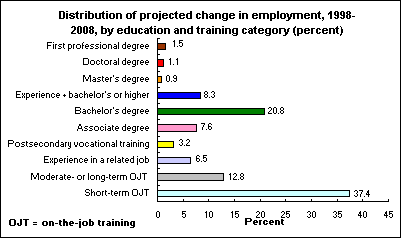An official website of the United States government
 United States Department of Labor
United States Department of Labor
Occupations requiring an associate degree or more education will account for 40 percent of total job growth from 1998 to 2008, according to new BLS projections.

[Chart data—TXT]
Jobs that require an associate degree will account for 7.6 percent of job growth, while jobs that require a bachelor’s degree will account for 20.8 percent. Occupations that require a degree beyond the bachelor’s are projected to account for 3.5 percent of employment growth in 1998-2008.
In addition, 8.3 percent of employment growth will be due to jobs that require work experience plus a bachelor’s or higher degree. Most jobs in this category are managerial or administrative.
The education and training category that is projected to account for the most job growth is short-term on-the-job training, with a share of 37.4 percent. The majority of jobs in this category are administrative support occupations; operators, fabricators, and laborers; and service occupations.
Projections of occupational employment are a product of the Employment Projections program. To find out more, see articles from the November 1999 issue of Monthly Labor Review.
Bureau of Labor Statistics, U.S. Department of Labor, The Economics Daily, Education requirements and job growth at https://www.bls.gov/opub/ted/1999/dec/wk1/art02.htm (visited July 12, 2025).

